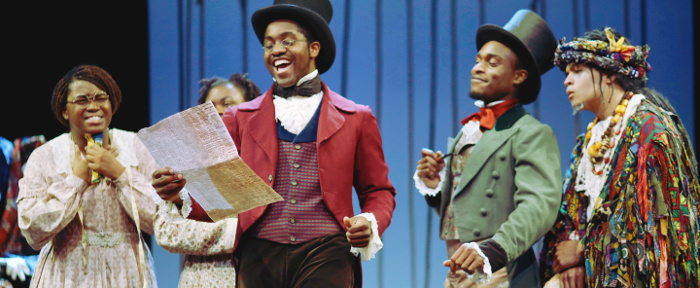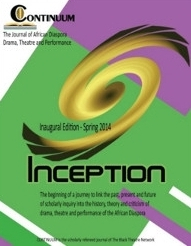
The African Company Presents Richard III. Produced at Dartmouth College. Visit our photo gallery.
Continuum:
Theatre and Performance
TABLE OF CONTENTS
Technical Notes/Browsing the Journal
At the Moment of Birth: A Note from the Managing Editor
Freda Scott Giles, Managing Editor
An Introduction to the First Issue of Continuum: Toward an Anthropology of Inception
Paul K. Bryant-Jackson, Editor-in-chief
ARTICLES
![]() Mourning, Orature, and Memory: Cultural Performativity as Historiography in Pearl Cleage's A Song for Coretta
Mourning, Orature, and Memory: Cultural Performativity as Historiography in Pearl Cleage's A Song for Coretta
Khalid Long
{-- ::Abstract: This essay explores how Pearl Cleage’s play, A Song for Coretta, engages with certain paradigms of cultural performativity, namely mourning, orature, memory, and history. In doing so, the play is explored through theatre, performance, and cultural theories. Analyzing the play in this manner, it can be critically seen how Cleage joins fellow playwrights in their use of playwriting as historiographical method to document the African American experience.} ABSTRACT {/--} {-- ::Khalid Yaya Long is a PhD student in the Theatre and Performance Studies program at the University of Maryland, College Park. His research focuses on African American/Diasporic theatre history, drama, and performance; intersections of race, gender, class, and sexuality; directing and acting. Currently serving as the graduate student representative for the Black Theatre Association (ATHE), Khalid’s intended dissertation project traces the development of Black feminist aesthetics through the life and work of Glenda Dickerson.} BIO {/--}
In A Song for Coretta, the central action takes place at the public memorial for the First Lady of the Human Rights Movement, Coretta Scott King. Playwright Pearl Cleage has illumined the Black experience from a relatively narrowed perspective through her dramatization of five African American women patiently waiting in line to view the body of King. By and large, the perspective can safely be placed under the scope of a womanist positionality. Individually, the women have been asked why they've each come to mourn the late ancestor – particularly, when they've never even met her. In order to answer the question, the women must recall their past. . .
![]() Spreading the Sand: Understanding the Economic and Creative Impetus for the Black Vaudeville Industry
Spreading the Sand: Understanding the Economic and Creative Impetus for the Black Vaudeville Industry
Nadine George-Graves
{-- ::Abstract: This article argues that the beginning of the twentieth century contained a perfect storm of influences and motivations to create the Black vaudeville industry. Artists combined the aesthetics of many genres and businessmen saw the opportunity to serve a population wanting more respectable and professional entertainment. The creation of Toby may not have been ideal for all involved but it was an important early step in the organization and institutionalization of African American performance. It provided an invaluable platform for talent to develop both as performers and as entrepreneurs. Attention to this moment in history reveals not only a revaluation of aesthetics but also a burgeoning Black economic system based on the wants and needs of a population ready to move beyond subsistence-level livelihood into a larger political economy of leisure. At the heart, what was deemed “valuable” and the “stakes” of performance in Black vaudeville helped define an era. The professionalization of Black vaudeville signals a crucial shift in American history.} ABSTRACT {/--} {-- ::Nadine George-Graves (BA, Yale; PhD, Northwestern) is Professor of Theater and Dance at the University of California, San Diego. Her work is situated at the intersections of African American studies, gender studies, performance studies, theatre history, and dance history. She is the author of The Royalty of Negro Vaudeville: The Whitman Sisters and the Negotiation of Race, Gender, and Class in African American Theater, 1900-1940 and Urban Bush Women: Twenty Years of Dance Theater, Community Engagement and Working It Out as well as numerous articles on African American theater and dance. She is currently editing The Oxford Handbook of Dance and Theater. She is also an adapter and director. Her recent creative projects include Suzan-Lori Parks’ Topdog/Underdog and Anansi The Story King, an original dance-theater adaptation of African American folk stories using college students, professionals, and 4th graders. She currently serves as president of the Congress on Research in Dance (CORD).} BIO {/--}
The impetus for this research stems from questions sparked when I was researching and writing a book on the Whitman Sisters, a turn of the nineteenth into the twentieth century Black vaudeville troupe owned and operated by four Black women. Fascinated by the raced, classed and gendered political and social negotiations, I dug into this unlikely success story. The company pushed buttons and broke barriers left and right: cross-dressing; passing for white; desegregating theaters. Most impressive, though, was Mae Whitman who managed the company and, I argued, relied on certain gendered advantages to succeed in this mostly white male business. They succeeded aesthetically, helping to foster some of the greatest talent in the entertainment industry. . .
![]() To Be a Man: A Re-Assessment of Black Masculinity in Lorraine Hansberry's A Raisin in the Sun and Les Blancs
To Be a Man: A Re-Assessment of Black Masculinity in Lorraine Hansberry's A Raisin in the Sun and Les Blancs
Julie M. Burrell
{-- ::Abstract: The first Black woman to pen a Broadway play, Lorraine Hansberry scripted a majority of male protagonists. Critics tend to see Hansberry’s depiction of Black men as either an unfortunate departure from her feminist concerns, or as damaging representations of Black masculinity. In contrast to such views, this essay maps the trajectory of Hansberry’s career-long project of scripting positive visions of Black masculinity, from the politically progressive, while still patriarchal, structures of masculinity in A Raisin in the Sun, to the heterogeneous performances of revolutionary masculinity in Les Blancs. Further, in her role as public intellectual, Hansberry questioned prevailing assumptions about masculinity during her time. In the pages of The Village Voice, Hansberry challenged a group of white writers she termed the “new paternalists,” including Jean Genet and Norman Mailer, in order to dismantle stereotypes of Black men as violent and hypersexual.} ABSTRACT {/--} {-- ::Julie M. Burrell is an assistant professor of English at Cleveland State University, where she teaches courses in American literature. She is working on a book examining the Black left feminist theatre of the civil rights and Black arts movements.} BIO {/--}
At the close of Lorraine Hansberry's A Raisin in the Sun, Mama Younger makes this observation about her son, Walter Lee Younger: "He finally come into his manhood today, didn't he? Kind of like a rainbow after the rain."[1] This positive evaluation of Walter's masculinity marks a sea change in the female characters' perceptions of Walter, who previously had been viewed as irresponsible, immature, and as not living up to the precedent set by his father, Big Walter. By the end of the play, however, Walter's position as head of the Younger household is substantiated by his decision to move the family out of their Chicago tenement and into the white suburban enclave, Clybourne Park. Walter thus averts what could have been the play's potentially tragic denouement—the dissolution of the Younger family in the deadly Southside ghetto—with action the women in his family find nobly masculine. . .
![]() Toward a Critical Vocabulary for African Diaspora Expressivity
Toward a Critical Vocabulary for African Diaspora Expressivity
Paul Carter Harrison
{-- ::Abstract: Recognizing that Black Theatre comes in several different forms and that its contents vary greatly, it now becomes abundantly clear that we must begin to distinguish between those works that fall squarely under the current rubric of Black Theatre…(biographical chronicles, personal and collective histories, celebrations, domestic dramatizations, etc.)…and those works that aspire toward challenging inquiries of cosmos and existential dilemmas. These challenging and aspirational works engage highly inventive theatricality and ritual without being seduced by the whimsy of the avant garde. Thus, in (re)branding Black Theatre, we must begin to explore theatrical performances beyond popular culture, i.e. Hip Hop, and examine the significance of post Black Afrological vs Eurological constructions in the performance aesthetics of Neo-Black Theatre and AfroFuturism. What I am suggesting in this essay is an examination and affirmation of highly inventive practices that can be identified under a rubric beyond the popular insinuations of Black Theatre.} ABSTRACT {/--} {-- ::Paul Carter Harrison, Visiting Scholar/Artist at Emory, is an award-winning playwright/director/theatre theorist whose work has been produced and published in both the United States and Europe. A native New Yorker, he has had a long artistic association, as writer/director, with the Negro Ensemble Company that had produced his earlier plays, Tophat,Abercrombie Apocalypse, and the celebrated Great MacDaddy for which he was recipient of an Obie Award. Harrison is the author of The Drama of Nommo (1973), a seminal work on African Diasporic expression , and co-editor of the 2002 publication of Black Theatre: Ritual Performance in the African Diaspora. He is co-director of the 2014 NEH sponsored institute: Black Aesthetics and African Centered Cultural Expressions: Sacred Systems in the Nexus Between Cultural Studies Religion and Philosophy} BIO {/--}
Over the past forty years, we have accepted the expedient rubric of Black Theatre, Black Music, Black Poetry, Black Dance, Black Visual Art without a culturally specific critical language to make valid assessments about what makes the expressive product Black. For most African Americans it suffices if the expressive product, in whatever genre, simply tells "our story", irrespective of "how" or what aesthetic choices are engaged to tell the story. Yet, Porgy and Bess is a Eurocentric fabrication of Black life that has never been considered a Black Opera or Black Musical, but rather, an American Opera on a Black theme which reaffirms how often the Black experience has driven much of the American historical narrative. . .
PRODUCTION REVIEWS
![]() Fela! National Broadway Tour
Fela! National Broadway Tour
Sharrell D. Luckett
On November 23, 2009 a provocative new musical based on the life of revolutionary Nigerian artist/activist Fela Anikulapo-Kuti played on Broadway. From 2011 to 2013 this musical toured globally. FELA! garnered eleven Tony nominations, winning three: Best Choreography, Best Costume Design, and Best Sound Design. Through the use of captivating images and a book and lyrics that supplied unflinching details of a life of political struggle, FELA! captured the relentless political stance of a revolutionary leader, heightening the production's political impact and relevance. . .
![]() The Road Weeps, The Well Runs Dry. Los Angeles Theatre Center (LATC)
The Road Weeps, The Well Runs Dry. Los Angeles Theatre Center (LATC)
Tony Fitzgerald
Marcus Gardley's the road weeps, the well runs dry presented at the Los Angeles Theatre Center (LATC) combines history, myth, sexual variance and magical realism. Like his earlier workevery tongue confess, this play is epic in scope sketching multi generation characters in a confluence of the real and the metaphysical. Gardley uses ethnographic research and historicity to substantiate a community of Black Seminoles relocated by the American government to what is now present day Oklahoma during the mid nineteenth century. This in itself may not be that unique to the African American dramatic canon but Gardley's play is told from the perspective of his male leads involved in an intimate relationship. . .
PHOTO GALLERY



